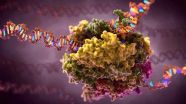(Press-News.org) Taking inspiration from nature, researchers have created a versatile model to predict how stalagmite-like structures form in nuclear processing plants - as well as how lime scale builds up in kettles.
"It's a wonderful example of how complex mathematical models can have everyday applications," said Dr Duncan Borman, from the School of Civil Engineering at the University of Leeds, a co-author of the study.
The main aim of the research, which is published in print today in the journal Computers & Chemical Engineering, is to reduce the number of potentially harmful manual inspections of nuclear waste containers.
"We were approached by the National Nuclear Laboratory and Sellafield Ltd to solve the problem of predicting the shapes that precipitates from nuclear process solutions can form in containment chambers," said Dr Borman.
Study co-author Professor Daniel Lesnic from the School of Mathematics at the University of Leeds, added: "Our first thought was to find a suitable analogy in nature. At first we looked at how lava flows from a volcano to the ocean, but the formation of stalagmites in caves mimics the process much more closely.
"Geologists have well-established models for the formation of stalagmites. So we are taking models from one field of science and applying them to a completely different discipline."
Within the nuclear industry, hazardous salt solutions can arise within industrial containment vessels. The salt solution precipitates out, forming structures with strange morphologies that bear a resemblance to stalagmites. If left unchecked, they could build up and cause a problem in the nuclear containment chamber. Currently, these containment chambers are checked regularly to prevent this from happening.
In the study, the researchers used an existing model for predicting stalagmite growth over millions of years as a starting platform. To take into account the full complexity of the mechanism by which the solid is formed, the model was then adapted to include the chemical and physical properties of the particular salt solution of interest to the nuclear industry, a more realistic fluid flow, and to consider the sensitivity of results to varying temperature.
Lead author of the study, Dr Mike Dawson from the School of Chemical and Process Engineering at the University of Leeds, who started the research during his PhD studies, said: "It took many months of intensive research to develop the model. The big test came when we tested the model against real data from the National Nuclear Laboratory.
"Our model stood up to the test. For the first time it was possible to predict the morphology of these complex crystallising flows reliably."
Dr Borman said: "This breakthrough provides a new tool for the National Nuclear Laboratory and Sellafield Ltd, with the potential to save both money and continue to ensure they are at the forefront of world-leading safety technology."
The new model also has wider application to other industrial and domestic situations where a salt solution precipitates out and causes problems, such as forecasting the precise shape and location of build-up in pipes or heat exchangers - or how lime scale will collect within a kettle.
Dr Borman said: "The processes underlying the build up of lime scale in a kettle are remarkably similar: the flow of a liquid containing a dissolved mineral - in this case calcium carbonate from hard water - over a surface of changing temperature, can result in solids precipitating out and leaving the build up of solid material behind.
"Using the model we have developed, manufacturers could improve the design of kettles such that these unwanted build-ups are minimised by repositioning filaments or designing them so that deposits form in locations that are easy to clean."
INFORMATION:
Further Information
The research paper, Moving boundary models for the growth of crystalline deposits from undetected leakages of industrial process liquors, is published in the journal Computers & Chemical Engineering on 4 December 2014: http://www.sciencedirect.com/science/article/pii/S0098135414002701
Mike Dawson's research was funded by a CASE PhD studentship offered by the National Nuclear Laboratory, Sellafield Ltd and the Engineering and Physical Sciences Research Council (EPSRC).
The researchers are available for interview. Please contact Sarah Reed, Press Officer at the University of Leeds.
Scientists at Nanyang Technological University (NTU Singapore) and Penn State University in the United States have successfully discovered one of modern human's ancient lineages through the sequencing of genes.
World-renowned geneticist from NTU, Professor Stephan Christoph Schuster, who led an international research team from Singapore, United States and Brazil, said this is the first time that the history of mankind populations has been analysed and matched to Earth's climatic conditions over the last 200,000 years.
Their breakthrough findings are published today ...
Wetlands are among the most productive ecosystems on Earth. Yet with increasing urbanization and agricultural expansion, wetlands around the globe are in danger. Better mapping of wetlands worldwide will help in their protection.
But compiling globe-spanning maps of wetlands is impeded by the dramatic diversity and evolving dynamics of wetlands, and by myriad difficulties in doing field work.
To develop a better model, Gong Peng and other scientists at the State Key Laboratory of Remote Sensing Science, Chinese Academy of Sciences, in Beijing incorporated hydrologic, ...
A natural substance present in red wine, resveratrol, inhibits the formation of inflammatory factors that trigger cardiovascular diseases. This has been established by a research team at the Department of Pharmacology of the University Medical Center of Johannes Gutenberg University of Mainz (JGU) working in collaboration with researchers of the Friedrich Schiller University in Jena and the University of Vienna. Their results have recently been published in the scientific journal Nucleic Acids Research.
Despite the fact that they eat more fatty foods, the French tend ...
When you go to bed, and how long you sleep at a time, might actually make it difficult for you to stop worrying. So say Jacob Nota and Meredith Coles of Binghamton University in the US, who found that people who sleep for shorter periods of time and go to bed very late at night are often overwhelmed with more negative thoughts than those who keep more regular sleeping hours. The findings appear in Springer's journal Cognitive Therapy and Research.
People are said to have repetitive negative thinking when they have bothersome pessimistic thoughts that seem to repeat in ...
This news release is available in German.
In quantum optics, generating entangled and spatially separated photon pairs (e.g. for quantum cryptography) is already a reality. So far, it has, however, not been possible to demonstrate an analogous generation and spatial separation of entangled electron pairs in solids. Physicists from Leibniz University Hannover and from the Physikalisch-Technische Bundesanstalt (PTB) have now taken a decisive step in this direction. They have demonstrated for the first time the on-demand emission of electron pairs from a semiconductor ...
Some patients with non-small cell lung cancer (NSCLC) have changes in the anaplastic lymphoma kinase (ALK) gene, which can drive the development of their cancer. A drug recently developed by Pfizer, crizotinib, targets ALK and is currently given to patients with ALK positive lung cancer when their cancer has worsened after initial chemotherapy. Now doctors have investigated the use of crizotinib in patients with ALK positive lung cancer who have not yet received any chemotherapy treatment.
Dr Fiona Blackhall, a senior lecturer in The University of Manchester's Institute ...
New York | Heidelberg, 4 December 2014 Studying the motion of electrons in a disordered environment is no simple task. Often, understanding such effects requires a quantum simulator designed to expose them in a different physical setup. This was precisely the approach adopted by Denis Makarov and Leonid Kon'kov from the Victor I. Il'ichev Pacific Oceanological Institute in Vladivostok in a new study published in EPJ B. They relied on a simulator of electronic motion subjected to noise stemming from a flux of sound waves.
Their findings could lead to semi-conductor devices ...
A new, innovative "dashboard" from the National Institute of Standards and Technology (NIST) won't help you drive your car, but it will help enable reproducible research in biology.
In a recent paper in the journal Nature Communications,* an international multi-laboratory team demonstrates a new software tool, the "erccdashboard," to evaluate the performance of experimental methods used to study gene expression. The analysis tool is designed for use with RNA spike-in controls developed by the NIST-hosted External RNA Controls Consortium (ERCC**). These ERCC controls are ...
Scientists from the Institute of Zoology with the Chinese Academy of Sciences have devoted years of their careers to study the astounding diversity hidden in the depths of the Xishuangbanna tropical rain forests. In a recent paper published in the open access journal ZooKeys Prof. Shuqiang Li and his team reveal 30 new spider species, which constitutes a minor share of what is yet to be found in this biodiversity hotspot.
Xishuangbanna is situated in the southern part of Yunnan with the Lancang (Mekong) River flowing through it. The region is well-known for its rich biodiversity ...
Los Angeles, CA (Nov 4, 2014) Most women can make all the milk their baby needs, but some mothers turn to medications to help increase their supply. While some specialists encourage the off-label use of domperidone to stimulate breast milk production, some studies have suggested it may be related to negative side effects, including irregular heartbeat and sudden cardiac death. In a new article out today, researchers concluded that although domperidone can increase breast milk production, and there is no known risk to the babies who drink the milk, risks to women are still ...




